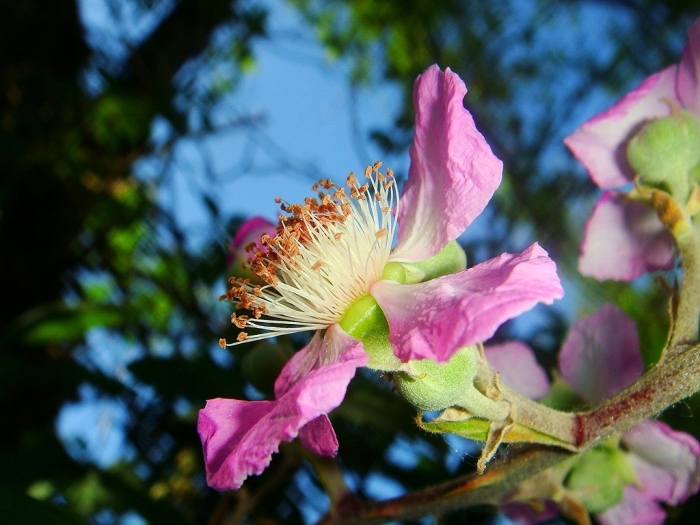Elmleaf Blackberry
(Rubus ulmifolius)
Elmleaf Blackberry (Rubus ulmifolius)
/
/

© Gianni Del Bufalo bygdb
CC BY 4.0
Image By:
© Gianni Del Bufalo bygdb
Recorded By:
Copyright:
CC BY 4.0
Copyright Notice:
Photo by: © Gianni Del Bufalo bygdb | License Type: CC BY 4.0 | License URL: http://creativecommons.org/licenses/by/4.0/ | Uploader: gianni_del_bufalo | Publisher: iNaturalist |



















Estimated Native Range
Summary
Rubus ulmifolius, commonly known as elmleaf blackberry or thornless blackberry, is a semi-deciduous shrub native to a variety of habitats including open woodlands, forest edges, and riparian areas across Europe and North Africa. It has also become naturalized in parts of the United States, Australia, and South America. This robust plant can grow up to 16 feet tall and is characterized by its arching canes and palmately compound leaves with woolly undersides. The shrub produces pink to white flowers in late spring to early summer, followed by edible blackberries that are attractive to both humans and wildlife.
Elmleaf blackberry is valued for its fruit production and is often used in fruit gardens and for naturalistic plantings. It can also provide erosion control on slopes due to its spreading habit. In cultivation, it prefers full sun to part shade, moist but well-drained soils, and it tolerates a range of soil types. While it is known for being less aggressive than other blackberry species, it can still spread via root suckers, potentially becoming problematic. Regular pruning is recommended to maintain its shape and promote fruiting.CC BY-SA 4.0
Elmleaf blackberry is valued for its fruit production and is often used in fruit gardens and for naturalistic plantings. It can also provide erosion control on slopes due to its spreading habit. In cultivation, it prefers full sun to part shade, moist but well-drained soils, and it tolerates a range of soil types. While it is known for being less aggressive than other blackberry species, it can still spread via root suckers, potentially becoming problematic. Regular pruning is recommended to maintain its shape and promote fruiting.CC BY-SA 4.0
Plant Description
- Plant Type: Shrub
- Height: 5.75-9.75 feet
- Width: 8.25-9.75 feet
- Growth Rate: Rapid
- Flower Color: White, Pink
- Flowering Season: Spring, Summer
- Leaf Retention: Deciduous
Growth Requirements
- Sun: Full Sun, Part Shade
- Water: Medium
- Drainage: Medium, Fast
Common Uses
Bee Garden, Bird Garden, Drought Tolerant, Edible*Disclaimer: Easyscape's listed plant edibility is for informational use. Always verify the safety and proper identification of any plant before consumption., Showy Flowers
Natural Habitat
Open woodlands, forest edges, and riparian areas across Europe and North Africa
Other Names
Common Names: Elmleaf Blackberry, Wild Blackberry, Thornless Blackberry
Scientific Names: , Rubus ulmifolius, Rosa ×andegavensis var. lemaitrei, Rubus abruptus, Rubus aetneus, Rubus albescens, Rubus albiflorus, Rubus amoenus, Rubus amoenus, Rubus amoenus var. hispanicus
GBIF Accepted Name: